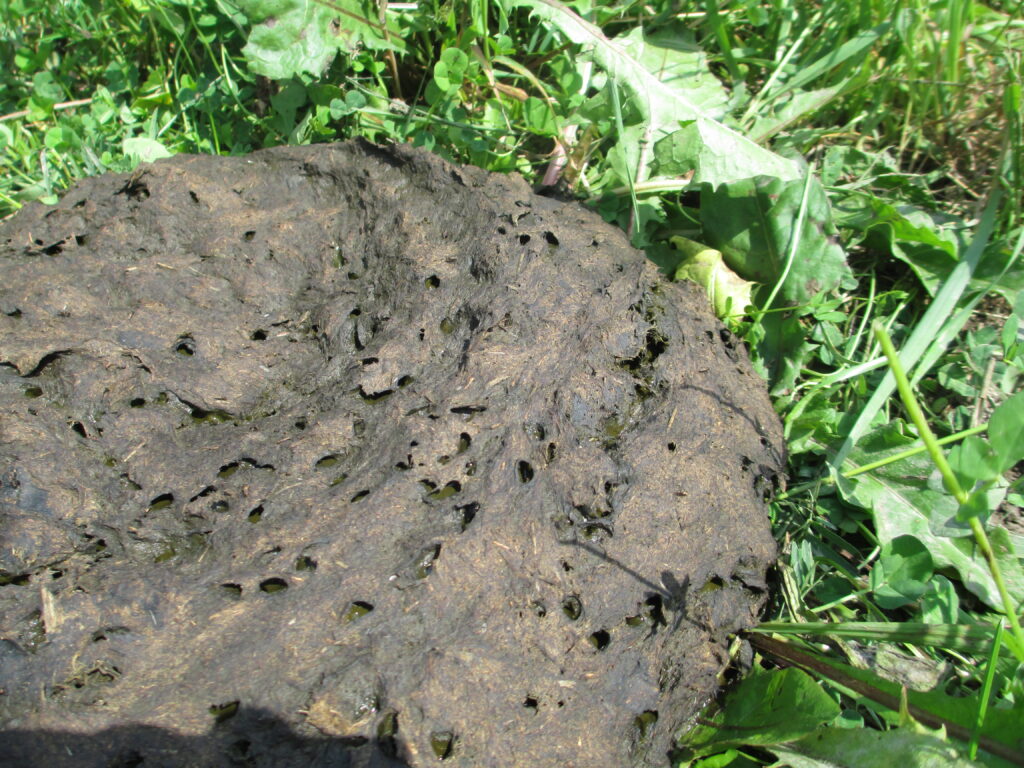Manure analysis is necessary because the quantities of nutrients contained in manure, especially the phosphorus and potash components, will vary from farm to farm. Type of livestock, ration, bedding, added liquids and storage system all affect the final nutrient analysis. Using average values for a livestock class is useful as a last resort, but the range of nutrient values within the same manure type can vary greatly. Phosphorus tends to be concentrated in the solids, while potassium levels tend to be higher in the liquid portion, therefore the level of agitation will affect nutrient levels being applied to a field. Fertilizer adjustments based on a manure analysis will be more accurate than those based on average values, however average values can be fine-tuned for future fertilizer application where analysis results are available after application.
Above-average levels of nitrogen, phosphorus or trace elements in manure may be an indication that dietary levels are higher than required. Amino acid-balancing for nitrogen, reducing the amount of phosphorus in the mineral supplements or adding phytase (an enzyme that increases phosphorus efficiency in the animal) may help reduce these nutrients in manure. Consult a livestock nutritionist before making ration changes.
Manure analysis is available from several laboratories in Ontario. Sample after complete agitation (liquid) or thorough mixing (solid) each time the storage is emptied and send the sample for analysis. After several analyses, a trend in results should become evident. As well, sampling should occur when there are changes in ration or other management factors.
When sending a sample to the lab, fill a plastic jar about half-full, secure the top, place in a plastic bag and store in a cool place until shipping. Most labs have manure sample jars available upon request. Glass jars pose a safety risk as they may break during transit, and therefore should not be used. Clean plastic peanut butter jars are a good option because they will not shatter and they have screw-on lids.
Analysis should include total nitrogen, ammonium-nitrogen (NH4-N), phosphorus, potassium and dry matter. Micronutrients, including sulphur, pH, organic matter and C:N ratio (for solid manure) analysis can provide valuable data for fertilizer application. Labs accredited for OMAFRA soil test return analysis results with “as-applied” percentages for nitrogen, phosphorus, potassium and dry matter, as well as mg/kg (or ppm) of ammonium nitrogen and micronutrients. On most reports, percentages of phosphorus, potassium and significant micronutrients from manure are converted to commercial fertilizer equivalents and potential commercial fertilizer reductions are often reported.
The best way of determining the amount of each nutrient from manure is to analyze a sample. Unfortunately, this is not always possible, as in the case of a new barn. In this case, average values will provide an estimate of the nutrients available to the crop.
Refer to OMAFRA factsheet Available Nutrients and Value for Manure from Various Livestock Types for estimates. It is based on the average results from manure analyses from the accredited labs in Ontario. Nitrogen is reported as available N under various application systems. Phosphate and potash values are reported as nutrients available to replace fertilizer nutrients. Use these values as the starting point in crediting nutrients from manure application.
To prevent burning the crop, applications of liquid manure should not exceed 55 kg/ha (50 lb/acre) of ammonia (NH3). While the ammonia concentration will depend on the type of manure and how it is stored, typically this limit is equivalent to 33,600–45,000 L/ha (3,000–4,000 gal/acre).
